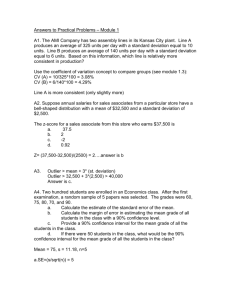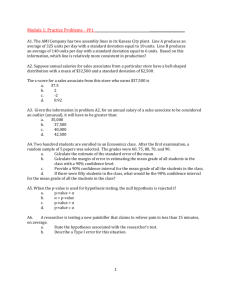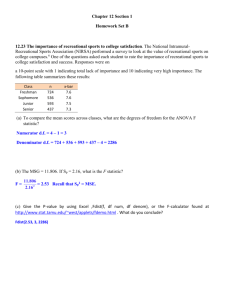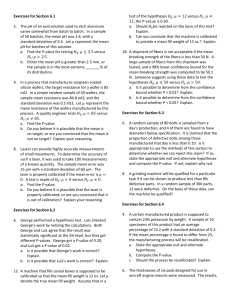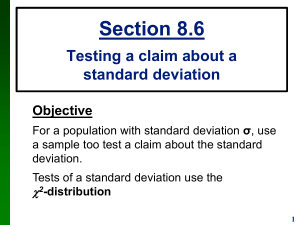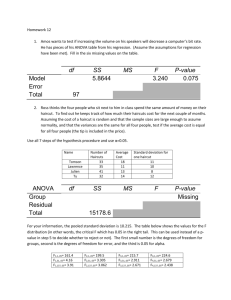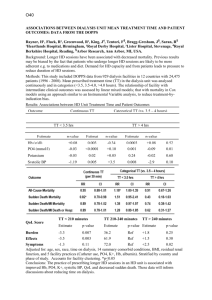Class 09 concept questions with anwers.
advertisement
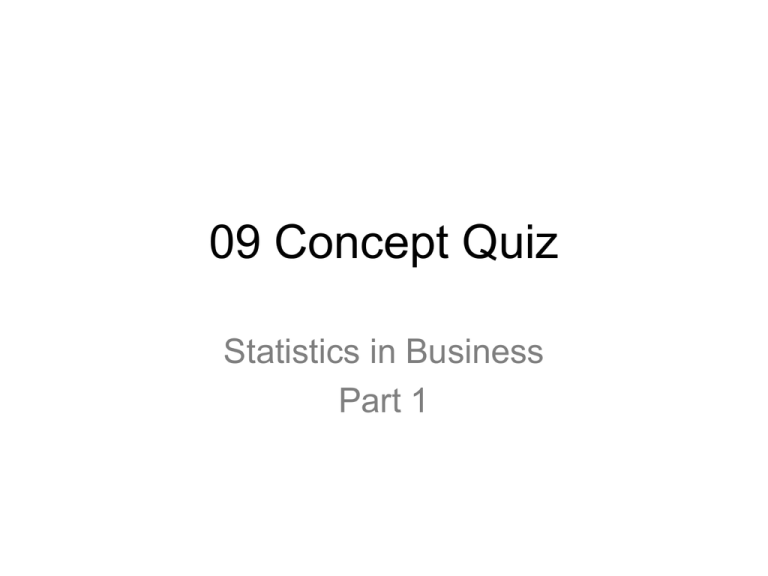
09 Concept Quiz Statistics in Business Part 1 QUESTION 1 • In an effort to be more global, Bo multiplied each student’s height by 2.54 and divided by 100 to convert to meters. Al used the original heights expressed in inches. Which statement is least true? A. B. C. D. Bo’s sample mean height will be 0.0254 times Al’s. Bo’s sample standard deviation will be 0.0254 times Al’s. Bo’s sample range will be 0.0254 times Al’s. Trick question…A,B,C are all true. Multiplying by a constant multiplies the sample mean, standard deviation, range, mode, and median by that same constant. The sample variance is multiplied by the constant squared. QUESTION 2. • There were n=100 values of the continuous variable X in the database. Al calculated the sample mean of the first 40 values. Bo calculated the sample mean of the last 60 values. Cy calculated the sample mean of all 100 values. Which of the following statements is most true? A. Based on sample sizes, Al’s sample mean will be smallest. Bo’s will be in between. Cy’s will be largest. B. Cy’s average will be in between Al’s and Bo’s. C. It is impossible to know ahead of time how the averages will come out. The sample mean of all 100 will be a weighted average of the sample means of the smaller groups—and therefore must be in between the averages of the two smaller groups. Try it and see. QUESTION 3 • A class of 100 had 40 athletes (variable A is 1 for athlete, 0 otherwise) and 60 males (variable M is 1 for male, 0 otherwise). How will the sample standard deviations of these two variables compare? A. B. C. D. The sample standard deviation for A will be higher. The sample standard deviation for M will be higher. The sample standard deviations will be equal. It is not possible to know how the sample standard deviations will come out. The sample standard deviation (and variance) measures expected distance from the sample mean. They will be equal in this case because the data are mirror images of each other. QUESTION 4 • O 87 Right Wrong 62 149 Total E 74.5 74.5 149 Having slept through the classes on Binomial and Normal, Di used a chi-squared GOF test on the Wunderdog Data. Recall that the p-value calculated using 1-normdist(87,74.5,6.1,true) was 0.0203. A. B. C. D. Di’s p-value will be > 0.0203 Di’s p-value will be = 0.0203 Di’s p-value will be < 0.0203 It is impossible to know without running numbers. There are two equivalent ways to test H0: pright=pwrong=1/2. The GOF test is “2sided” and gives a calculated p-value of 0.0406. Try it and see for yourself. QUESTION 5 • Thinking that more data are always better, Bo copied the entire database and appended it to the original database. Al calculated descriptive statistics using the original, and Bo used the expanded database. Which is not true? A. Bo’s counts will be twice Al’s. B. Bo’s sample means will equal Al’s sample means. C. Bo’s sample standard deviations will be very close to Al’s. D. Trick question, all the above are true. The sample standard deviation is the square root of the average squared distances from the sample mean. Doubling the number of those distances will not change the average squared distance. Bo’s sample standard deviation won’t be much different from Al’s. More data doesn’t imply more variability in those data. QUESTION 6 • In the problem of points, we figured out that the person ahead 2 to 1 in a best of five series should get .75 of the prize. Suppose a team is ahead 3 games to 2 in a best of seven series. If the series is canceled, the team ahead should get… A. B. C. D. More than 0.75 The same 0.75 of the prize Less than 0.75 A parade in New York City. In both cases, the leader needs to win at least one of three remaining games. QUESTION 7 • The GOF test for the normality of lorex fill amounts gave a calculated chi-squared statistic of 7.577 and p-value of 0.371. Bo doubled both the O and E counts and recalculated the chi-squared statistic and p-value. Which is true? A. B. C. D. O E Distances 6 10 17 33 36 14 16 12 6.13 10.38 19.12 27.04 29.37 24.51 15.71 11.73 0.003 0.014 0.235 1.313 1.494 4.506 0.005 0.006 Calc chisq pvalue Bo’s chi-sq will be higher and pvalue lower Bo’s chi-sq will be lower and pvalue higher Bo’s chi-sq and pvalue will be the same. Impossible to tell ahead of time. Doubling the sample size doubles each distance. Any O/E gap is less likely due to chance the bigger the sample size. 7.577 0.371
